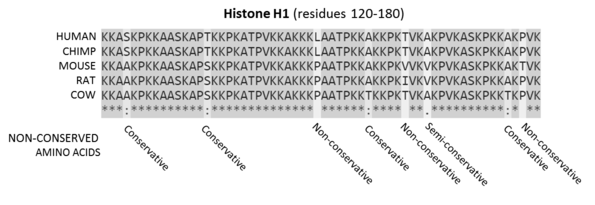217:
100:
58:
79:
for residues 120-180 of the proteins. Residues that are conserved across all sequences are highlighted in grey. Below the protein sequences is a key denoting
258:
76:
277:
251:
128:
105:
282:
118:
244:
20:
84:
32:
187:
232:
8:
39:
123:
113:
80:
62:
28:
24:
169:
47:
161:
228:
38:
The proportion of segregating sites within a gene is an important statistic in
271:
51:
43:
165:
173:
87:(:), semi-conservative mutations (.), and non-conservative mutations ( ).
57:
224:
133:
66:
152:
Fu, YX (Oct 1995). "Statistical properties of segregating sites".
216:
70:
99:
95:
35:, semi-conservative and non-conservative mutations.
269:
252:
259:
245:
50:. For example it is used to calculate the
56:
270:
19:are positions which show differences (
211:
13:
151:
14:
294:
42:since it can be used to estimate
215:
98:
180:
154:Theoretical Population Biology
145:
1:
139:
54:neutral evolution statistic.
31:). Segregating sites include
23:) between related genes in a
231:. You can help Knowledge by
7:
129:Sequence alignment software
106:Evolutionary biology portal
91:
10:
301:
210:
119:Ultra-conserved element
188:"Clustal FAQ #Symbols"
166:10.1006/tpbi.1995.1025
88:
85:conservative mutations
60:
278:Population genetics
40:population genetics
124:Sequence alignment
114:Conserved sequence
89:
81:conserved sequence
75:Sequences are the
63:sequence alignment
25:sequence alignment
240:
239:
17:Segregating sites
290:
261:
254:
247:
219:
212:
203:
202:
200:
198:
184:
178:
177:
149:
108:
103:
102:
300:
299:
293:
292:
291:
289:
288:
287:
268:
267:
266:
265:
208:
206:
196:
194:
186:
185:
181:
150:
146:
142:
104:
97:
94:
74:
69:, of mammalian
12:
11:
5:
298:
297:
286:
285:
283:Genetics stubs
280:
264:
263:
256:
249:
241:
238:
237:
220:
205:
204:
179:
143:
141:
138:
137:
136:
131:
126:
121:
116:
110:
109:
93:
90:
65:, produced by
9:
6:
4:
3:
2:
296:
295:
284:
281:
279:
276:
275:
273:
262:
257:
255:
250:
248:
243:
242:
236:
234:
230:
227:article is a
226:
221:
218:
214:
213:
209:
193:
189:
183:
175:
171:
167:
163:
160:(2): 172–97.
159:
155:
148:
144:
135:
132:
130:
127:
125:
122:
120:
117:
115:
112:
111:
107:
101:
96:
86:
82:
78:
72:
68:
64:
59:
55:
53:
49:
45:
44:mutation rate
41:
36:
34:
30:
26:
22:
21:polymorphisms
18:
233:expanding it
222:
207:
195:. Retrieved
191:
182:
157:
153:
147:
46:assuming no
37:
33:conservative
16:
15:
77:amino acids
272:Categories
197:8 December
140:References
73:proteins.
52:Tajima's D
48:selection
29:conserved
27:(are not
225:genetics
134:ClustalW
92:See also
67:ClustalO
192:Clustal
174:7482370
71:histone
172:
223:This
83:(*),
229:stub
199:2014
170:PMID
162:doi
274::
190:.
168:.
158:48
156:.
61:A
260:e
253:t
246:v
235:.
201:.
176:.
164::
Text is available under the Creative Commons Attribution-ShareAlike License. Additional terms may apply.
